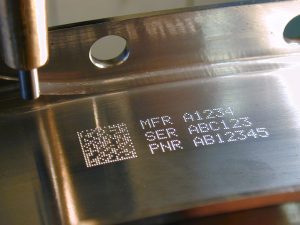What is a Data Matrix Code?
What is a Data Matrix Code?
A Data Matrix Code stands as a robust 2D barcode, designed to efficiently store substantial data. Diverging from the linear arrangement of black and white bars in a 1D barcode, a 2D barcode employs a grid of black and white squares. This grid can be thoughtfully structured into either a square or a rectangular pattern, enabling a more versatile and data-rich encoding approach.
They look a bit like very small crossword puzzles and are often found on packaging, posters and on manufacturing parts. Data is stored both horizontally and vertically, resulting in significantly greater storage capacity than a 1D barcode. 2D barcodes are machine readable and can pass on text or numeric data in the blink of an electronic eye.

A Data Matrix code is the name given to a particular type of 2D barcode as defined by the ISO/IEC 16022 international standard.
Each Data Matrix has 2 solid adjacent borders that form an ‘L’ shape. This ‘L’ is called a “finder pattern” and ensures that the code can be read regardless of its orientation.
Data Matrix codes are formed by a series of equally sized squares and so are ideal for marking with dot-peen machines.
Each Data Matrix can store up to 3116 numbers or 2335 alphanumeric characters from the full ASCII range, and this data can even be encrypted for security purposes.
A key advantage of a Data Matrix Code is error proofing.
Codes can be designed to ensure that even when partially damaged or obscured a majority of data can be recovered from them.
Is this different to a QR Code?
Yes. A QR code (Quick Response Code) is another type of 2D barcode, first developed in the Japanese automotive industry, but has since become widely used in advertising applications. The amount of data that can be stored in a QR code depends on the data type and the error correction level. There are four correction levels, the higher the level, the less storage capacity. A QR code is recognisable by three distinctive squares at the corners.
Pryor supplies a range of products for marking, reading and managing 2D barcodes. Data Matrix codes are believed to be the more secure (less hackable) codes and are favoured where high security is deemed important. Pryor’s dot-peen, laser, chemical etching and inkjet machines are all suitable for Data Matrix marking applications.
Want to know how 2D Data Matrix Codes can be used in Supply-Chain Traceability? Find out more here
Please visit our Machinery website to view the Dot Peen, Laser and Chemical Etching machines that can be used to apply a data matrix code